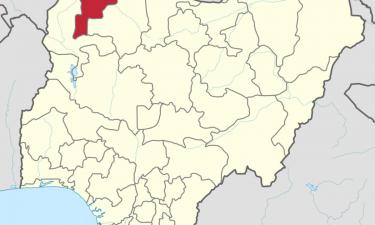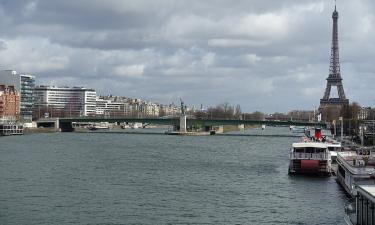Deep-Water Worms Bring Up Idea of Life on Distant Planets
Scientists discovered that deep-water worms can live well without the energy of the Sun
What is going to happen to the mankind, when continents and shelves run out of their oil and gas reserves? This moment is not that far, really. One has to think about it very seriously now. As it turned out, biologists can suggest a way out of the situation.
It has been more than 50 years since zoologists learned about the existence of pogonophoras – small worms about ten or twenty centimeters long. Those worms live in the ocean, at a very large depth. The most peculiar feature of those animals is the fact that they do not have a digestive system. They have no mouth, no intestines, no anal hole. On the other hand, the deep-water worms are rather developed creatures from the point of view of their evolution. They have a closed circulatory system, a rather complicated nervous network. They also have a spinal pipe and a brain in their head part. Scientists of many countries have been studying pogonophora worms for decades. Soviet zoologists were not an exception. However, scientists unveiled the secret of their nutrition only after they discovered giant relatives of those worms at hydrothermal depths of the ocean – vestimentiferas.
Those creatures produced an immense impression on the researchers of the deep. First of all, no one even expected to find living creatures so deep. Second of all, the spots of the deep life like that exist in the hostile environment of hydrosulfuric volcanic discharge. To crown it all, the creatures are beautiful: the pitch darkness of the ocean floor revealed thick interlacements of white tubes about 2.5 meters long and three or five centimeters thick. Worms dwell inside those tubes, sticking their gorgeous crowns of red-hot tentacles out. Vestimentiferas surprised not only geologists, who found them first. Zoologists were really astounded as well, when they started studying them. They found no indication of digestive systems at all.
The oceanology institute of the Russian Academy of Science conducted several expeditions to study hydrothermal communities in various areas of the World Ocean. Russian zoologists got an opportunity to study those tube-dwelling worms. Vladimir Malakhov, the chairman of the department of invertebrate zoology of the Moscow State University, and Sergey Galkin, a Doctor of Biological Sciences of the Russian Academy of Sciences, were the ones, who got that unique opportunity. Zoologists determined that the flaky tissue of large cells inside their bodies, which is called trophosome, is all filled with symbiotic bacteria. Those microbes oxidize hydrogen sulphide. The energy, which is produced with that chemical process, is then used for the synthesis of organic substances. Worms simply use the organic substances that bacteria produce.
The circulatory system of the worms is organized in a way to make every capillary run through every cell of the trophosome. Capillaries carry oxygen, which is necessary for the worms, and also hydrogen sulphide, which is needed to the worms’ bacteria. This way of co-existence is mutually beneficial for the both sides. Vestimentifera worms do not need any other food, which makes digestion organs totally useless.
Scientists discovered later that pogonophora worms live owing to the symbiosis with autotroph bacteria. There was a slight difference, though: pogonophora bacteria oxidize not hydrogen sulphide, but methane. Russian zoologists studied the spreading of those animals on the seafloor of the World Ocean, and made maps of their living. Scientists came to conclusion that those worms could be used in order to search for gas fields on the ocean floor. However, those strange worms are deep-water creatures, so the gas fields that might be found with their help, would be located at the depth, which would not make any extraction possible. Modern ways of oil and gas extraction do not have any equipment that would help to extract the raw material from such large depths. However, there was a time, when people had no idea of developing ocean shelves. Politicians might need to think that the ocean floor with potential sources of energy carriers have not been divided between the countries yet. Pogonophora dwelling maps might be successfully used for that.
Professor Malakhov said that those deep-water worms brought up another idea: “When scientists talk about the life on planet Earth – when the life started, or how to preserve it – they basically imply the life that is based on photosynthesis. This process is performed by plants with the use of the solar power. The Sun is considered to be the requisite source of life in this respect. The mode of life of vestimentifera worms shows that life is possible without any sunlight. The temperature regime of hydrothermal emissions is not conditioned with the Sun, but with deep geophysical processes, which take place in the center of our planet. The planet is warmed from within. Vestimentifera worms are the living creatures that will survive any global catastrophe that might take place on Earth in the future - the fall of an asteroid, a nuclear winter, or the global freezing.” Since there is a creature that managed to use the warmth of the planet itself, nothing can stop other creatures (people) from doing the same too.”
The Earth is a living planet. Various components get mixed up in its bowels all the time: heavy elements go down, forming the nucleus of iron and nickel, while light elements get smelted upwards, forming the earth mantle. That movement produces volcanic activity, which results in the emission of hot gases. The discovery of vestimentifera worms and other living creatures, which live owing to the tectonic energy of the planet, allows to assume that there might be life found far from the Sun, on large satellites of Jupiter or Saturn, for example. Those giant planets have huge satellites, which are like earth-type planets themselves. Such satellites like Io, Europe and others are covered with a thick layer of ice, which consists of water and frozen carbonic acid, ammonia and methane. Those planets get very little warmth from the Sun. However, there were powerful volcanoes found both on Io and on Europe satellites. Those volcanoes emit gases and fragments right in the adjacent space. If there are volcanoes, then it means that there are areas with high and moderate temperature underneath them. There might be primitive life found in those areas. Maybe, that life is based on chemosynthesis, which is not really a primitive form of life.
Subscribe to Pravda.Ru Telegram channel, Facebook, RSS!






